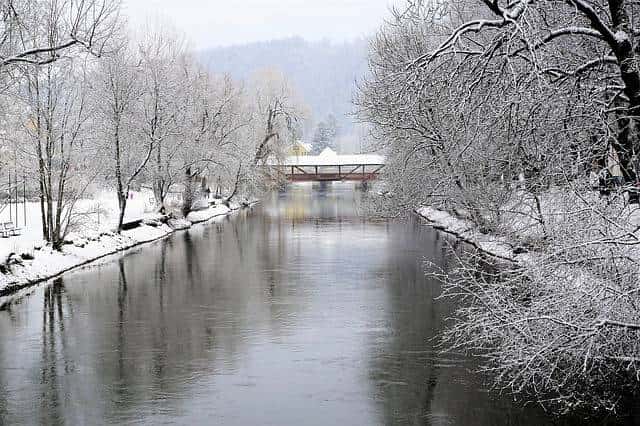What is Snowmelt? -An Introductory Guide (explained)
Compiled by Stanley Udegbunam ||updated Nov 21, 2020
Trying to learn about snowmelt? Search no further✨
This guide gives you a hands-on introduction to snowmelt.
It explains its occurrence over time, a little case study in Africa countries, alongside its effect and importance.
Let’s get started…
AFRILCATE
WHAT IS SNOWMELT?
Snowmelt is a term commonly used in hydrology to describe surface runoff produced from melting snow.
Snowmelt runoff is a major component of the water cycle in many regions.
It contributes immensely to surface water and also infiltrates the soil to recharge underground geologic formations.

OCCURRENCE OF SNOWMELT
As air temperatures rise, snowpack begins to melt.
Sensible heat transfer occurs when the air temperature is different from the snowpack temperature.
In other words, conduction of heat between the snowpack and the underlying soil occurs if there a temperature difference exists.
Rainstorm can cause snowpacks to thaw leading to rapid snowmelt.
In extreme circumstances, this can create a large flood.
In mountains, it can take several months before runoff because the snowmelt occurs at a slow process.
The annual peak flow in certain areas can arise from either pure snowmelt or rainfall or a combination of both, leading to a mixed frequency distribution.
Freshly fallen clean snow has a very high albedo value (0.95 – 0.98) making it difficult to absorb heat energy.
However, the albedo value decreases with:
- the age of the snow,
- sun angle, and
- the presence of contaminations like debris and dust.
Reduction in albedo value signifies greater radiant heat absorption.
This will will increase the rate of snowmelt and a corresponding increase in surface runoff.
Snowmelts contributes greatly to annual runoff to watersheds and drainage.
Lack of water stored as snowpack in the winter can affect the availability of water for the rest of the year.
This can have an effect on surface water, causing a decrease in water availability for irrigation and city supplies.
Do you know what Albedo is? see our article

ADVERSE EFFECT OF SNOW MELT: FLOODING
Rapid snowmelt can cause flooding if the soil is impermeable or has exceeded its infiltration capacity within a given time.
This is often triggered by a heavy rainstorm.
In some parts of the world, such as in the Pacific Northwest of the United States, annual springtime flood events occur when the rain descends on existing snowpacks.
This is termed a “rain-on-snow event.”
Flooding caused by “rain-on-snow event” has been associated with mass-washing of hill slopes, damage to riparian (areas alongside streams) zones, and loss of life.

Rapid snowmelts causes flooding
Due to the slow rate of snow melting, mountain snowmelt usually is not a primary cause of flooding.
Rapid snowmelt can also cause erosion and debris flows.
Frozen snowmelt like ice causes soil freezing which greatly reduces the soil’s infiltration capacity.
They block the soil pores and this leads to a large runoff to drainage systems or water bodies.
Confused about the word “runoff”?, Our article will also help out: water runoff
SNOWMELT IN AFRICA
Do you think it’s impossible for snow to fall in Africa due to its high climate temperature?
Let’s find out…

photo src: getty image
This Sahara region is renowned for its extreme temperature because it’s annoyingly hot in the day but freezing at night.
Experts said snowfall was rare and a local resident back this statement by adding that he had seen snow there five times in the past 40 years.
Several mountain ranges in North Africa like the Tibesti Mountains and Algeria’s Ahaggar Mountains see snowfall on a more regular basis.
The Tibesti Mountains span northern Chad and southern Libya and see snow on average every seven years.
Sutherland is proved to be the coldest town in South Africa with temperatures going well below freezing at night (as low as -16 degrees Celsius) throughout the winter.
The Atlas Mountains in Morrocco get continuous snowfall in winter months from December to February and it serves as a good resort for skiing.

skiing in Morocco
The Kingdom of Lesotho located in Southern Africa is an exceptionally mountainous country and it’s the coldest country in Africa.
Snow is common in Lesotho, with some peaks retaining a covering of snow year-round.
Its lowest point of 1,400 meters (4,593 ft) crowns a record of the highest low point of any nation on Earth.
Snow cover in Lesotho may last for only a few days before disappearing completely; there are fewer occurrences of snow cover lasting for up to 10 days.
In terms of subaerial extent, 40-50% of snowmelt occur within the first day.
At lower altitudes (< 1 500 m), 75-100% of subaerial snow extent usually melts within the first day.
During the early snow season, remaining snow cover at altitudes below 2,000m melts at an average rate of > 50% per day.
In contrast, at altitudes over 2,500m, snow normally melts at a rate of less than 30%/day.
When the snow cover persists between 6 – 10 days after a snowfall, snowmelt occurs at different percentages depending on the snow season.
- For early season, snowmelt occurs at an average rate of 33% per day but decreases to 15%/day at an altitude of 3,400m
- During the mid-snow season, snowmelt occurs at an average of 15% per day across all altitudes.
- During the late-snow season, snowmelt occurs at an average of 38% per day.
You can see that the rate of snowmelt runoff is dependent on the altitude and the snow season.
Other factors that affect snowmelts are: daily radiation, wind speed, dust, mean temperature, and precipitation.
IMPORTANCE OF SNOWMELT
Out listed below are the various importance of snowmelt.

- Snowmelt is generally a major source of water inflow to lakes and wetlands, and the presence of significant soil frost can increase the amount of water reaching them as surface runoff.
- It is an important consideration for water supply and design flood analysis. In some areas, snowmelt event runoff may be more appropriate for the design of water storage facilities.
- Predicting snowmelt runoff from a drainage basin can be helpful while designing water control projects.
- Snowmelt is used for flow forecasting, agricultural productivity, soil moisture monitoring, and drought management.
- Snowmelt is a source of water for groundwater recharge.
Part of the snowmelt that percolates through soil recharges the aquifers that hold groundwater.
Now…Over to You!
There you have it. Our Introductory guide on snowmelt.
Hope you enjoyed it😊
Now, I will like to hear from you.
What’s your country, do you experience snowfall over there?
And have you been affected by flooding due to rapid snowmelt before?
Share your thoughts and answers in the comment section below.


